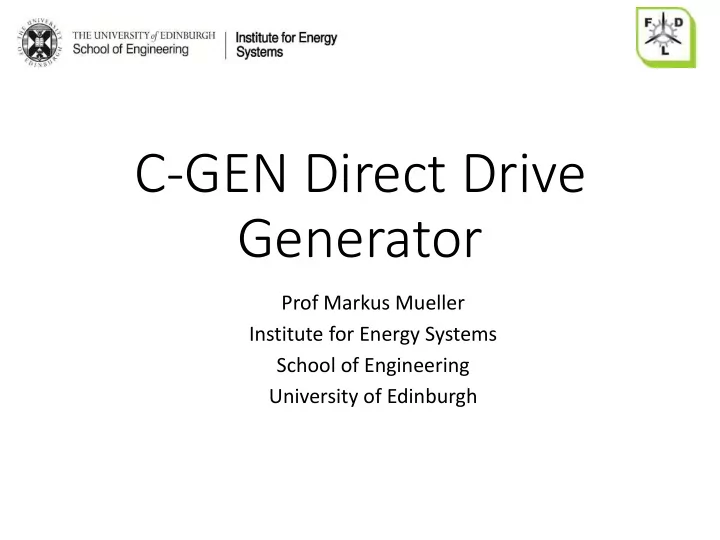

C-GEN Direct Drive Generator Prof Markus Mueller Institute for Energy Systems School of Engineering University of Edinburgh
Project Plan • C-GEN Technology • Lab Prototypes • 1MW Demonstrator • Unique Selling Points & Benefits
C-GEN Technology Auxiliary Cooling: Specifically designed air cooling system, with alternatives being researched and prototyped Mechanical Integration: Adaptable to new and known configurations and topologies, Adjacent C-Cores with ability to meet individual turbine requirements Single C-Core Permanent Magnet Rotor Module Assembled Stator Module Generator Rotor Generator Radial Flux Generator Composed of Several C- Generator and Converter Circuits: Cores Each stacked PMG is electrically and magnetically independent Core Patent: Generator and Magnetic Flux • Dedicated power converter per PMG Conducting Unit • Few or all generator modules connected Granted : USA, China, Japan, Canada, Australia to a single converter Pending: Europe Stacked Generators • Circuit to suit wind conditions for For Higher Ratings maximum yield 25/09/2017 3
Lab Prototype Development • Objectives: • To prove the fundamental engineering principles • To verify design tools and procedures • To demonstrate manufacture and assembly techniques • To show high level of performance in terms of efficiency • To build confidence in developing a 1MW demonstrator
Prototype 1: 20kW radial-flux Test aim: does analytical design tool ( left ) match with numerical modelling (Finite Element model, right ), e.g. airgap flux density. Broad agreement between design tool and numerical tools. 25/09/2017 5
Prototype 1: 20kW radial-flux Test aim: Can the generator produce power efficiently over a broad range of loads and speeds? 100% 95% 100rpm 90rpm Efficiency 80rpm 90% 70rpm 60rpm 50rpm 85% 80% 0 5 10 15 20 25 Power (kW) High efficiency over a range of speeds and loads. 25/09/2017 6
Prototype 2: 15kW radial-flux Test aim: compare analytical design model and experimental results, e.g. voltages Analytical models match up with experimental results. 25/09/2017 7
Prototype 2: 15kW radial-flux Test aim: Can the generator produce power efficiently over a broad range of loads and speeds? High efficiency over a range of speeds and loads. 25/09/2017 8
Prototype 2: 15kW radial-flux Test aim: Can C-GEN technology safely produce power when mounted to a wind turbine? Power results on a 15kW wind turbine. 25/09/2017 9
Prototype 3: 25kW axial-flux Aims: • Can we build an axial-flux version? • Can we build a multi-stage version? • Can we build a modular version? • Can we cast rotor modules? 25/09/2017 10
Multi-stage Axial Flux C-GEN • Rotor Construction Stator Construction
C-GEN Design Validation Satisfactory Testing of initial demonstrators Full validation of design tools & models Non-Magnetic Stator Stacking of three stators in rotor Segment module providing inherent Permanent redundancy Magnet Rotor Segment
1MW Demonstrator NGenTec 1MW Prototype Technical Characteristics • Demonstrate technology at high power • Four equal stages (250kW) – any combination of stages can be satisfactorily run (One, Two, Three or Four stages) • Power = 1MW • Output voltage Un=690 V • Speed circa. 12 rpm • Single stack of potential 6MW machine • Insulation / Temperature rise Class F 25/09/2017 13
1MW Prototype Detailed Test Results Pre-assembly Tests 25/09/2017 14
Early stage demonstration validation Pre-assembly Thermal Tests Full Scale Test Module • Single rotor module with stator module • 4 stages • Test rig allows worst case thermal scenario (no rotation but with electrical losses) 25/09/2017 15
Early stage demonstration validation Pre-assembly Thermal Tests Test aim: Experimentally validate CFD and other thermal modelling Maximum coil temperatures for 51kW electrical losses from experimentation is 60°C; from CFD (above) it is 64°C 25/09/2017 17
1MW Prototype Test Results 25/09/2017 18
1MW PMG Overview Rotor Modules Stator Structure Rotor Structure Test Gearbox to provide required generator speed and support structures Stator Modules 25/09/2017 19
No Load Voltage • All generator stages well balanced • Demonstrating accurate design and manufacturing 25/09/2017 20
Waveform Analysis UL-L from digital oscilloscope. Stage 1, Phase 3 25/09/2017 21
Full Load – All Stages • Good correlation between initial design and measured temperature rise • Not more than 15% temperature variation from the mean temperature rise • Less than 4% difference Vs CFD Speed Torque Output Line Phase Temp Coil Temp Coil Cooling (rpm) (kNm) Curren Current Block Block (m 3 /s) Power Rise – Rise – t (Amp) no no (kW) max min (Amp) ( O C) ( O C) 13.3 791 202 116.6 S3-F S1-0 6.3 1101 54.70 41.69 25/09/2017 22
Efficiency • Efficiency measurements well understood • Design work in hand to demonstrate higher values for future machines 96 95 94 93 92 91 90 Efficiency Efficiency (%) 89 88 87 efficiency 86 calculated… 85 84 83 82 81 80 79 78 77 76 75 0 200 400 600 800 1000 1200 Output Electrical Power (kW) 25/09/2017 23
Unique Selling Points Demonstrated C-GEN Technology provides the following benefits: • High reliability and availability • Reduced Levelised Cost of Energy • High efficiency across full operating range • Standardised components • Built in redundancy • Zero cogging torque • Reduced weight and size • Cost competitive
Recommend
More recommend